HTC One max Review - It's Huge
by Brian Klug on October 28, 2013 10:00 AM EST- Posted in
- Smartphones
- HTC
- Mobile
- One
- Snapdragon 600
- Android 4.3
- One max
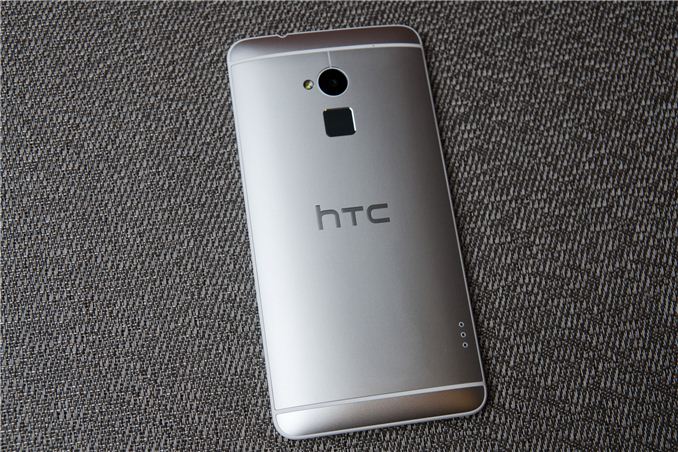
Big phones are all the rage right now. Although tablets promised the kind of extra screen real estate that would increase productivity while still retaining portability, there’s ultimately nothing more likely to be on your person than a phone. I wager that at least some of the success of the supersized smartphone form factor is still that a phone is ultimately always on your person, while a tablet still isn’t.
Today we’re looking at HTC’s newest member of its flagship One series, and its largest, the aptly named One max. Although HTC has been no stranger to larger display form factors (remember how big the HD2 seemed back in 2009?), the One max is to my knowledge the largest smartphone HTC has ever made, eclipsed only by the short lived HTC Flyer and Jetstream tablets. In the HTC phone portfolio, it’s easily the largest smartphone they’ve ever made, and that’s noteworthy.
The strategy for HTC’s One lineup seems to have been a simple one, differentiated by display size and form factor. We saw the flagship, dare I say midsized HTC One come first, then the smaller, lower end HTC One mini, and finally the huge HTC One max.
At a high level this strategy is pretty basic - offer three form factor options that yield almost the same experience. All three are predominately metal and share roughly the same industrial design notes, featuring an aluminum backside with top and bottom notches for antennas, center mounted camera, and LED flash. On the front, big stereo speaker grilles at the top and bottom, and the same button arrangement, just back and home.
I never had a problem locating the power button on the One, but then again I apparently have longer fingers than most. The power button moves down below the volume rocker on the One max, which does make sense since using your thumb to actuate power naturally positions your index finger right next to the fingerprint scanner.
I have no complaints about the buttons on the One max, they seem different somehow but still are communicative and don’t rattle around.
Up top there’s the headphone jack and IR port, which is slightly recessed. It isn’t the power button this time, just an IR window.
| HTC One mini | HTC One | HTC One max | |
| Height | 132 mm | 137 mm | 164.5 mm |
| Width | 63.2 mm | 68 mm | 82.5 mm |
| Thickness | 9.25 mm | 9.3 mm | 10.29 mm |
| Mass | 122 grams | 143 grams | 217 grams |
| Display Size | 4.3-inch | 4.7-inch | 5.9-inch |
| Display Resolution | 1280 x 720 | 1920 x 1080 | 1920 x 1080 |
| SoC |
1.4 GHz Snapdragon 400 (4x Krait 200) |
1.7 GHz Snapdragon 600 (4x Krait 300) |
1.7 GHz Snapdragon 600 (4x Krait 300) |
| Camera | 4 MP F/2.0 Ultrapixel with LED | 4 MP F/2.0 Ultrapixel with OIS and LED | 4 MP F/2.0 Ultrapixel with LED |
| Battery | 1800 mAh, 3.8V, 6.84 Whr | 2300 mAh, 3.8V, 8.74 Whr | 3300 mAh, 3.8V, 12.54 Whr |
| WiFi | 802.11a/b/g/n | 802.11a/b/g/n/ac | 802.11a/b/g/n/ac |
| Storage | 16 GB NAND | 32 GB NAND | 32 GB NAND + microSD |
If the dynamic range in size between the One mini and One is a 2 on an arbitrary scale of 1–10, the dynamic range between the One and One max is at least a 9. While the One mini really isn’t that much smaller than the normal One, the One max lives up to its namesake in a dramatic fashion. It’s positively huge, it literally is the One design taken to the max. The One max makes the Note 3 feel almost normal by comparison, and the entire normal sized 5-inch smartphone demographic feel downright small.
The One max is definitely a two-hand device, one handing it is difficult if not impossible, although I doubt that was anyone’s goal for this thing. It’s big in 2D dimensions, and it’s also somewhat heavy, at 217 grams, but I guess that’s expected given the material choices.
What’s interesting about the One max is that the truth is that its design is a lot more like a vastly larger One mini than it is the original One. We saw the mini come after the One and bring a plastic lip rather than the gorgeous diamond-machined edge that the One had, partly for cost reasons, partly for survivability when dropped on a hard surface. Truth be told, I can understand the rationale for having a plastic ring around the device and it making drops and blemishes a bit less destructive. I filed my HTC One down after a drop to my tile floor dented the chamfered edge a bit. The tradeoff however is that you’re now touching more plastic than metal.
I was initially turned off by the glossy plastic ring around the One mini, but if that was what had to take a hit to make the One mini the right price point for HTC to sell into operators and still make money, I was willing to deal with it. I’ll leave discussion of the faux-metal plastic speaker grille on the One mini for another day, which thankfully the One max doesn’t have.
Anyhow the One max inherits the same plastic ring around the edge design that the One mini debuted with. The polymer has been changed slightly, it’s a more matte, grittier finish that makes it a bit grippier and less chintzy feeling than the One mini’s slippery, glossy finish. The One max also includes aluminum speaker grilles, not the faux-metal plastic cutouts that adorn the One mini.
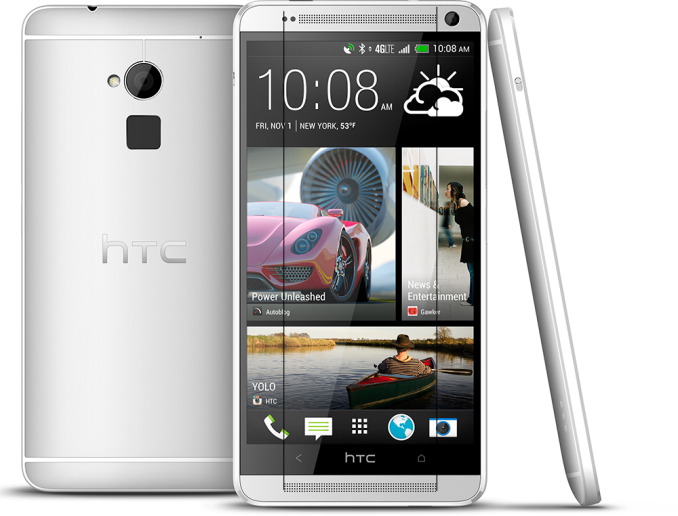
Now you also won't be able to unsee it (lines added to show asymmetry)
Let’s talk about the speaker grilles for a moment. What I loved about the original One design was how balanced everything felt. The polymer strips required for the antenna array carried over to the front and felt logical, it seemed like each cut had a purpose. On the One max however, I can’t get over how the speaker grille dots aren’t lined up and symmetrical at top. Something bugged me about the One max’s appearance for a few days until I noticed exactly what didn’t seem balanced anymore, so there’s that. I hesitate to make a big deal about it, but it might be a microcosm of what’s really weird about the One max.
The One max also takes a nod from a few of the Asian variants of HTC One which featured a removable back to accommodate two SIMs (when necessary) and a microSD card slot. The One max makes the removable back and microSD card slot standard, in addition to eschewing a SIM tray and enabling design commonality when dual SIM is necessary. What it doesn’t add is a removable battery, since HTC continues its use of a pyramid-like stack of display, battery, and PCB. Peel up the label and you’ll find out you’re looking at the top of some EMI cans and shielding rather than a battery, validating that. At the bottom of the HTC One max there’s no longer a Beats Audio silkscreen (since that partnership is over), instead just blank empty space. The nice thing about having the removable door is that the regulatory markings are on the inside, there’s no laser etched part and model text on the bottom third of the One max.
There’s a small slider on the left side of the One max which pops the removable door open, it then hinges and comes off completely.
There’s definitely a tradeoff associated with this approach though. For starters, although there isn’t much flex or play in the door after it’s attached, it requires a lot of effort to make sure the door is completely seated when re-attached. In addition there’s definitely a gap at top and bottom, which is unfortunate given HTC’s narrative about zerogap construction for the original One.
The only caveat is that the One max myself and a few others were sampled was in fact a PVT (Production Validation Test) as marked, so it’s possible the door is being slightly tweaked, but I doubt it’ll change much. I’ve said my part already on microSD cards and the fact that they’re going the way of the dodo in smartphones, I just don’t need one anymore, and definitely not at the expense of build quality. It is convenient not having to use a SIM ejector tool though, even if I carry one around all the time anyways. For the incredibly small percentage of users that clamors for an SD card every single smartphone launch, it’s at least one point which won’t be belabored so tiresomely this time.
In a lot of ways the construction of the One max is more like the One mini, and I fear that comes hand in hand with making what was an expensive design (the One) profitable, something HTC does need. It still is premium and combines metal and plastic in a pleasing way, but there clearly were tradeoffs on the road to the One max.
The One max isn’t so much a phablet as it is a huge phone. I don’t know if the supersized phone market is quite mature enough to really tell what the defining properties for a phablet are yet, but the scaled up One design makes the One max feel like a huge phone. HTC doesn’t go for an active digitizer and slide-out stylus with the One max, there’s an optional capacitive stylus that’s a standalone accessory, and the scribble application I’ll get to in a bit. I don’t think there’s anything wrong with that approach quite honestly (I wager not many Note users actually use the stylus), it’s just something to note.
HTC Power Flip Case
HTC also sampled their new battery case, which is like the flip case we saw for the One but includes a battery in the screen cover portion. Think the Surface’s new Power Cover, but for the HTC One max. The power flip case uses three pogo pins to connect the battery directly to the One max, it’s what the pogo pads on the back of the phone are for. The case snaps on around the perimeter of the One max, and the front portion folds over the display, just like the flip case. The units we were sampled weren’t final however, and had some issues with proper fit, although fit should be rectified in the final version.
The battery isn’t huge, at 1210 mAh and 3.75V (4.53 watt-hours), but it does give a boost as I’ll show in the battery section. It also does add weight what is already an unmistakably heavy phone, and makes using the fingerprint scanner a bit more awkward.
When the power flip case is attached you get a small plus sign on the battery symbol in the status bar. I’m not sure how this actually works in practice, as the One max seems to draw from both the internal battery and the external battery at the same time, rather than using the external battery to charge the internal one. It does boost battery life however.


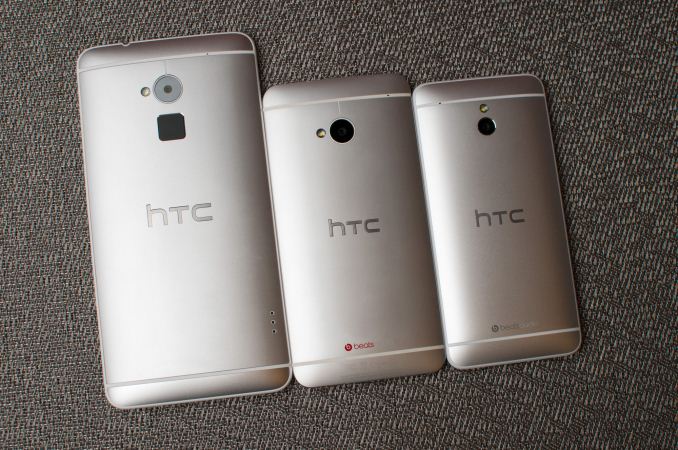
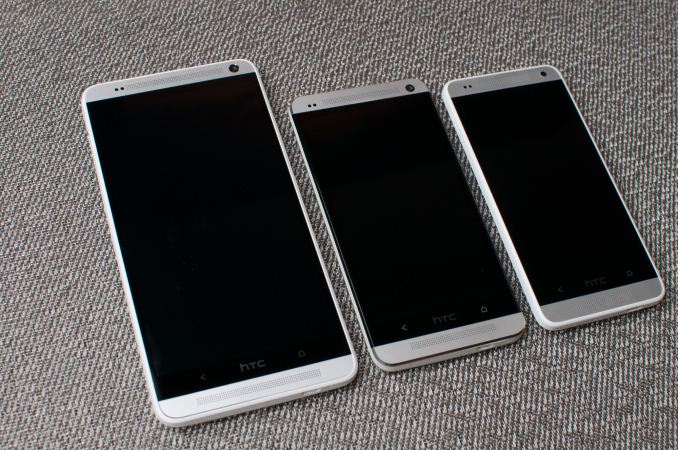
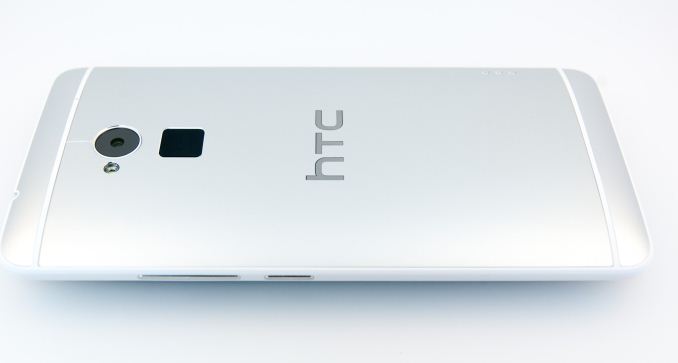
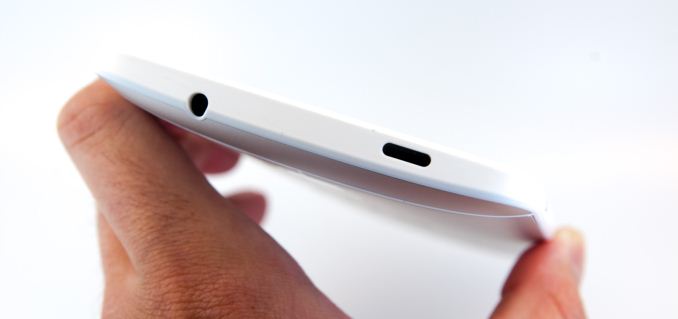
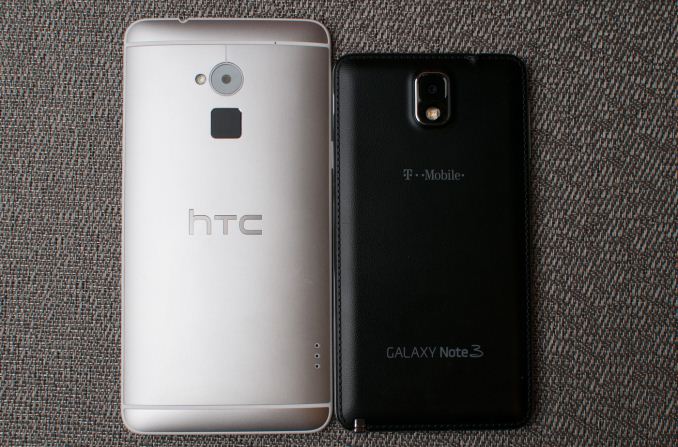
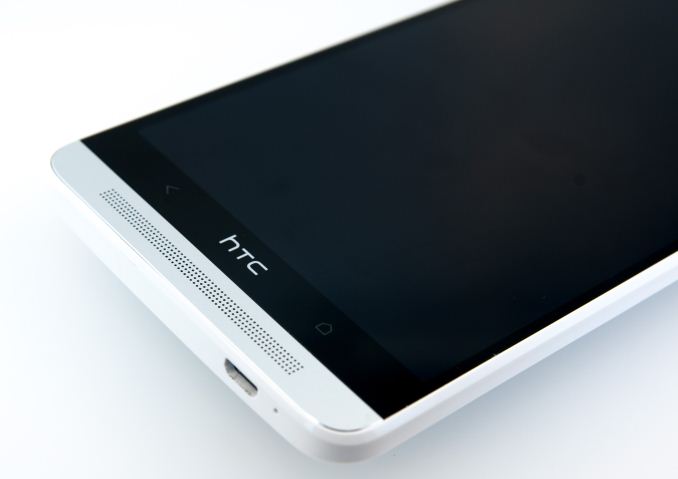


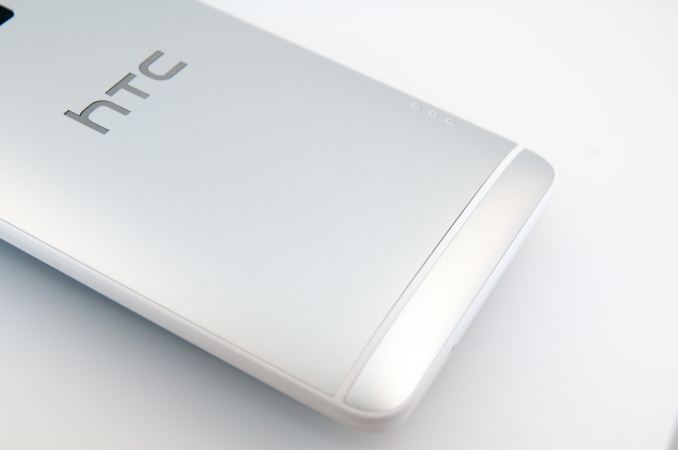
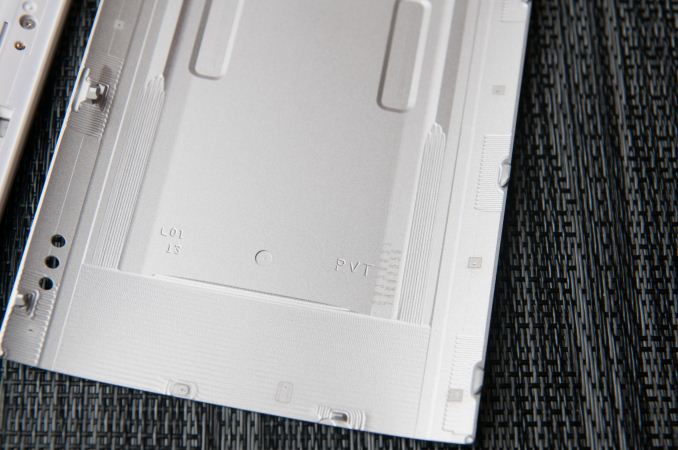






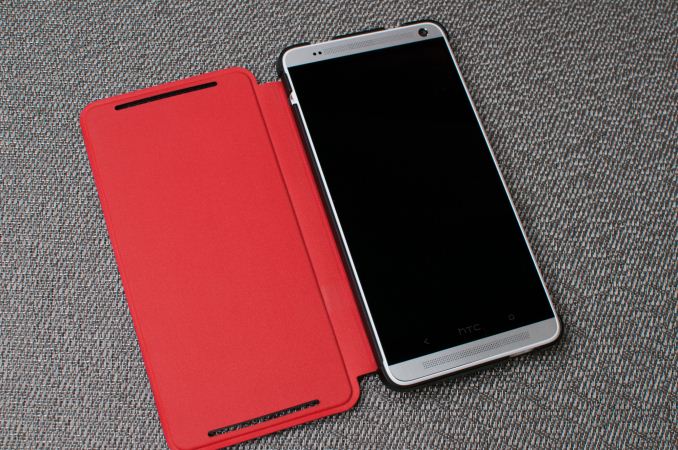
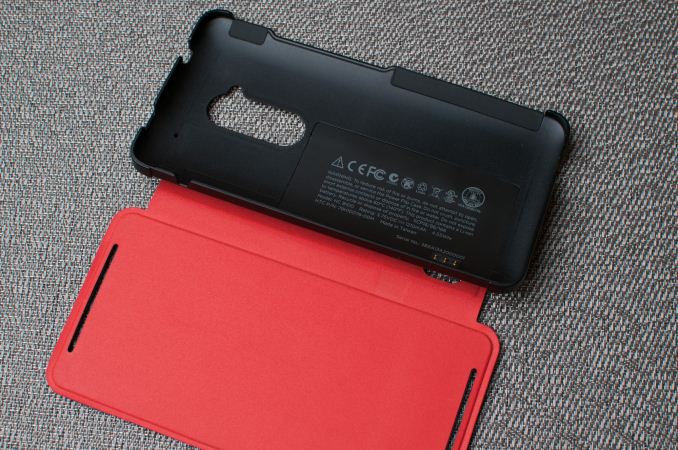








197 Comments
View All Comments
Ruevenator - Monday, October 28, 2013 - link
I store a lot of music on my phone. I have 16 GB internal and 64 GB external. Needless to say if I purchased a phone with 80 GB, I'd have to take out a car loan to pay for it. It's stupid to pay for internal OEM storage when you can buy if cheaper. As for "ruining the user's experience with external storage", I believe Apple is just greedy, refusing to give buyers a choice in fear that they might go somewhere else for memory. That is just one of the reasons not to buy an iPhone.ELPCU - Tuesday, October 29, 2013 - link
Dude, ur argument is SO WRONG. first, slow speed of microSD card does not matter that much, because OS has to be installed on Internal flash. Except OS, there is not much real advantage of using fast speed memory. Why? Note there is thing called RAM, and ur data transfer RAM first, and data will be used after that. Unless bottleneck is happening during tranfer from storage to RAM(which does not happen most case except loading OS and large size app loading), u will not suffer from lack of speed. So what is happening? most of time, you do not benefit from those read/write speed. Oh, also, you know what? Apple's lightning cable is USB 2.0. NOT 3.0. There is huge data tranfer speed cap difference btwn 2.0 and 3.0. 160MB/s is not even useful for data tranfer from PC to iPad, because it will have a bottleneck at 35MB/s(max of USB 2.0)And also, most popular microSD card in market today is probably that of Sandisk, and they give 18MB/s for reading, and 12MB/s for writing. which is OK enough.
BACK TO MAIN ARGUMENT, the advantage of having microSD comes from the fact that phone manufacturer does not give enough storage with REASONABLE PRICE. Most people, who are interested in microSD slot, wants microSD slot because their phone does not have enough storage or manufacturer charge ur money SOO MUCH, and guess what? Apple charge u 100 bucks for every storage upgrade. Because Apple do not have microSD card slot, customers are FORCED to buy those expensive extra storage. It is clear Apple will NEVER add microSD card slot no matter what kind of performance microSD card give. Do you know how much money Apple make out from that?
There is homepage called iSuppli. Go and look their data. They show u number called Bill of Material(BOM), and BOM difference btwn iphone 5s 16GB->32GB is 9.4 dollars. and 32GB -> 64GB difference is 10.2 dollars(not even close to twice of 9,4 dollar). Although BOM does not include AS cost, marketing cost, cost from transfering, licensing, etc, iSuppli generally call zero margin if BOM is about 66% of market price. In other words, if Apple cost u 15 bucks for increasing each level of storage, they will not lose any money. Considering they have HUGE margin rate, thanks to deceptive number of 2-year contract phone, upgrading phone storage without losing money is NOT a super-generous thing. BUT INSTEAD, they charge u 100 bucks. wow. they are making 85 bucks margin with 15bucks cost if u just see storage. this is TERRIBLY RIDICULUS. If u do not know this BOM number, 100buck looks ridiculus, but if u see BOM number, it looks TERRIBLY RIDICULUS. more than 550% margin rate? wow. With this level of ridiculus price, there is no way reasonable customer even try to UNDERSTAND storage policy of apple.
u said u can understand apple? I can not understand u dude.
TheinsanegamerN - Tuesday, October 29, 2013 - link
Ok, first of all, it's "you" not "u".Second, most of your argument is wrong.
"Why? Note there is thing called RAM, and ur data transfer RAM first, and data will be used after that. Unless bottleneck is happening during tranfer from storage to RAM(which does not happen most case except loading OS and large size app loading), u will not suffer from lack of speed"
What do you think the SD card is going to be used for? movies and music eat up more space than most apps, making your point completely rubbish. The whole argument was that cheap SD cards are slow to load data, then you say that it is not a problem, by stating that unless you are loading lots of data, there is not going to be an issue. The whole point is that SD cards are slow.
Third, the BOM argument makes no sense. If it only costs $15 to go from 16-32 GB, then why do they charge $100 for the upgrade? why not $25 or $30 or something like that? They would still make money. Or are you suggesting that most consumers are too stupid to figure out that apple is ripping them off?
Fourth, and finally: work on your English. You cannot make a long, legitimate argument if you type the same way that Peggy speaks in those credit card commercials.
flyingpants1 - Thursday, October 31, 2013 - link
Wow, what an asinine comment. What he said is completely accurate. All you could manage was this gem:" Third, the BOM argument makes no sense. If it only costs $15 to go from 16-32 GB, then why do they charge $100 for the upgrade? why not $25 or $30 or something like that? They would still make money. Or are you suggesting that most consumers are too stupid to figure out that apple is ripping them off?"
Seriously.
Homeles - Monday, October 28, 2013 - link
"It will be nice once they go out of business to be able to stop hearing from that tiresome segment of pretend geeks who treat their cellphones like how divas treat their purses - as fashion accessories."Textbook "No True Scottsman" fallacy right there.
Dentons - Monday, October 28, 2013 - link
You're absolutely right about Anand and Brian sometimes being "pretend geeks". If you think they're bad in these written reviews, you should listen to them on their podcast, or not.In far too many Anandtech podcasts, Brian and Anand banter for ages, (and in dreary detail) about their preferred metal skinned devices.
They could just as easily be hosting a podcast on the virtues of exquisite jewelery. It's terribly odd for writers who are so well versed in the underlying technology to morph into a fashionistas the moment smart phones are mentioned.
The shame of it is that Anand and Brian really, REALLY know their technology. Yet for whatever reason, they don't realize their metal skin fetishism is not a priority for most technology centered folks. One suspects that most of the readers on a site like Anandtech are far more interested in the underlying capabilities of a device than the exquisite luster of the diffused, metallic outer casement.
Diminish the fashion guys, get back to the tech.
cbrownx88 - Monday, October 28, 2013 - link
Can yall get off the fashion rant? Perhaps the metal preference is for a more ridged chassis/device or to achieve a desired weight/feel?Personally that's one of the reasons I love Macbooks - I hail from windows camp but after you see a MBP tumble down a flight of concrete stairs and not be absolutely shredded afterwards... you start to desire more designs that share those aluminum/steels/magnesium attributes.
superflex - Tuesday, October 29, 2013 - link
I'll venture a guess you own a plastic phone manufactured by a SK giant?Validation is a bitch, especially when your cheap ass phone is the kickball.
I'll venture another guess when Samsung intros a metal phone, you'll shut the fuck up and quit whining like a bitch.
Richard Paguirigan - Monday, October 28, 2013 - link
Lol,Samsung's flimsy, cheap-looking plastic phones are some of the ugliest phones around, they have that bluish tinted amoled screen and still manage to stutter although they have the latest chips. Their build quality is mediocre and their speakers suck, suck SUCK! I could care less about sd cards or removable batteries which ARE going by way of the dodo. get with the times...cryptech - Tuesday, October 29, 2013 - link
I spend most of my day in a cli and have 7.8GB available out of 16 on my mobile device. Go ahead and call me a pretend geek but I find it hysterical that just because you carry your video collection around on your phone you think you know a damn thing about the IT industry.